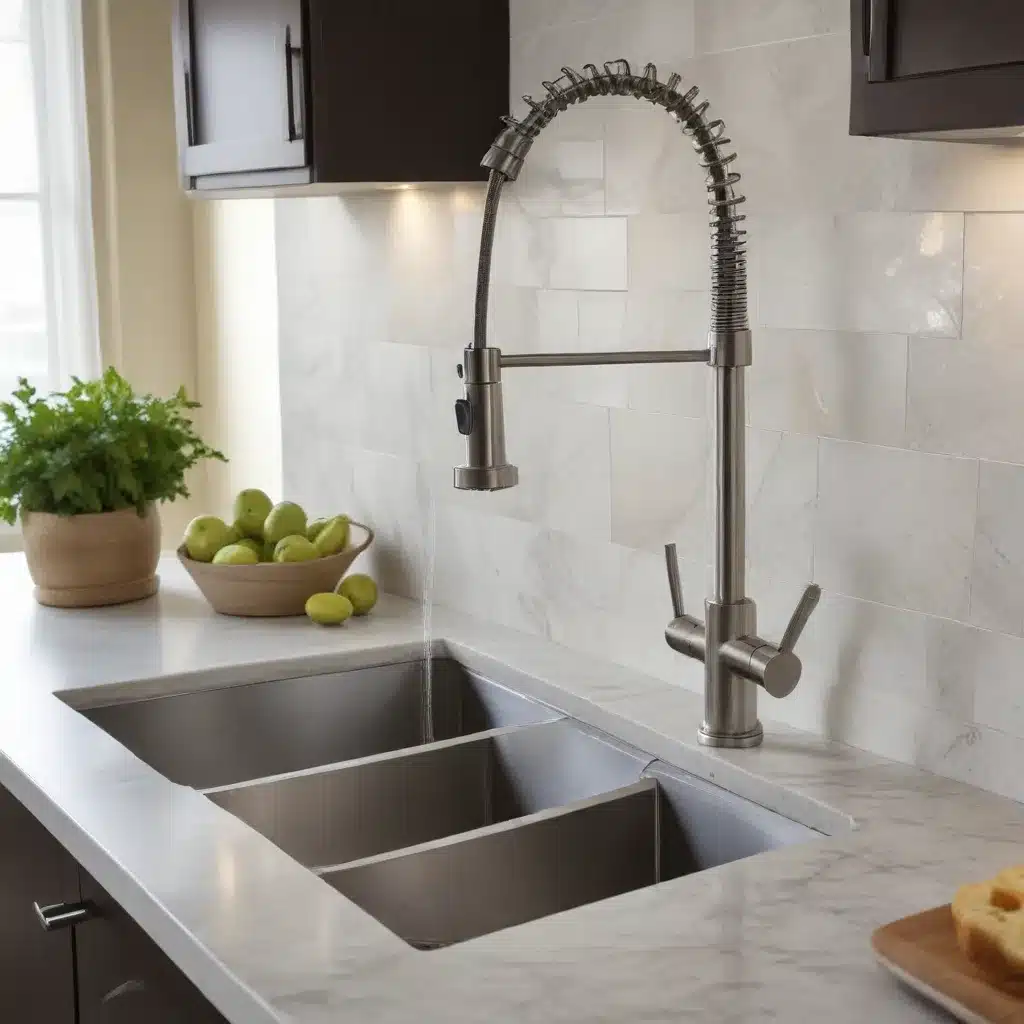
Understanding LEED Certification and Water Efficiency
As a seasoned plumbing and heating expert, I’m often asked for advice on upgrading kitchen fixtures to improve efficiency and sustainability. One of the most common questions is how to choose the right kitchen faucet – one that not only looks great but also helps maximize water savings and earn valuable LEED credits.
LEED (Leadership in Energy and Environmental Design) is a globally recognized green building certification program that aims to reduce the environmental impact of construction projects. Earning LEED certification is important because it demonstrates a commitment to sustainability, which can enhance property value, marketability, and resident satisfaction.
The LEED rating system places a strong emphasis on water efficiency, awarding points for reducing water usage throughout a building. This category includes fixtures like low-flow faucets, showerheads, and toilets. By selecting water-efficient kitchen faucets, you can significantly improve your project’s LEED score and contribute to its overall sustainability.
Evaluating Water Efficiency Standards
When choosing a kitchen faucet, one of the key factors to consider is its water efficiency, typically measured in gallons per minute (GPM). Standard kitchen faucets usually have a flow rate of 2.2 GPM, but more efficient models can reduce this to 1.8 GPM or even lower, without compromising performance.
The EPA’s WaterSense program is a voluntary certification that identifies plumbing fixtures, including faucets, that are at least 20% more efficient than the industry standard. WaterSense-certified kitchen faucets have a maximum flow rate of 1.8 GPM, making them an excellent choice for earning LEED Water Efficiency (WE) credits.
While WaterSense currently does not have specific criteria for kitchen faucets, the program is expected to expand its scope to include them in the near future. In the meantime, you can still find highly efficient kitchen faucet models that may not carry the WaterSense label but still exceed the standard flow rate.
Balancing Efficiency, Aesthetics, and Functionality
When selecting a kitchen faucet, it’s important to strike a balance between water efficiency, aesthetics, and functionality. After all, the faucet is a focal point in the kitchen and needs to not only conserve water but also enhance the overall design and user experience.
Look for faucets with modern, streamlined designs that complement your kitchen’s style. Many leading brands, such as Moen and Delta, offer a wide range of finishes and styles to choose from, including popular trends like matte black, brushed gold, and stainless steel.
In addition to the faucet’s appearance, consider its features and accessories. A pull-down or pull-out sprayer can make rinsing, cleaning, and filling large pots much easier, while further reducing water usage. Some faucets even incorporate hands-free or touch-activated technology for added convenience and water savings.
Maximizing LEED Water Efficiency Credits
To maximize your LEED WE credits, it’s essential to consider the efficiency of all water-using fixtures in your project, not just the kitchen faucet. The LEED rating system evaluates the overall water use reduction across the entire building, so choosing high-efficiency toilets, showerheads, and appliances can further boost your project’s score.
When calculating your LEED WE credits, the percentage of water use reduction is the key factor. A kitchen faucet with a 1.8 GPM flow rate would provide a 18% improvement over the standard 2.2 GPM. Combining this with other water-efficient fixtures, such as a 1.2 GPM bathroom faucet, can lead to an overall water use reduction of 30% or more, earning your project valuable LEED points.
Overcoming Common Misconceptions
As you navigate the process of choosing water-efficient fixtures for your project, it’s important to address some common misconceptions about LEED certification:
-
LEED is only for new construction: While LEED is primarily associated with new builds, the LEED for Existing Buildings program allows older properties to be certified by making sustainable upgrades, such as improving water and energy efficiency.
-
LEED is too expensive: While there are upfront costs associated with LEED certification, the long-term benefits often outweigh these expenses. LEED-certified buildings can qualify for tax credits and incentives, and they often have higher resale values.
-
LEED is just a marketing tool: LEED is much more than a marketing tool – it’s a globally recognized, rigorous certification with stringent sustainability standards. Achieving LEED certification provides measurable environmental, economic, and health benefits.
-
Efficient fixtures are too expensive: Eco-friendly kitchen faucets and other water-efficient fixtures are often competitively priced compared to traditional options. And the price difference is shrinking every year, making them a smart investment in the long run.
-
LEED doesn’t improve performance: While LEED is primarily a design-based certification, it has been proven to make buildings more eco-friendly over the long term. The program’s guidelines help ensure that design and material choices don’t sacrifice safety or stability for the sake of sustainability.
Partnering with Allora USA for Your Kitchen Faucet Needs
When it comes to selecting the perfect kitchen faucet for your LEED-focused project, Allora USA is an excellent partner. As a family-owned wholesale business with a focus on designers, contractors, and developers, Allora offers a diverse selection of high-quality, water-efficient kitchen and bath fixtures.
Allora’s kitchen faucets exceed water efficiency standards, with many models surpassing the requirements of the WaterSense program. By incorporating Allora’s products into your project, you can not only earn valuable LEED WE credits but also provide residents with beautiful, long-lasting fixtures that enhance their living experience and contribute to the overall sustainability of the building.
Allora’s professional support team is available to help you navigate the selection process, ensuring you find the perfect kitchen faucet that meets your design, budget, and performance needs. With guaranteed stock, warranties, and a commitment to quality, Allora can help you bring your vision for a sustainable, LEED-certified kitchen to life.
So, if you’re embarking on a kitchen renovation or new construction project, consider Allora USA as your trusted partner in choosing the right kitchen faucet – one that blends water efficiency, exceptional design, and practical functionality to create a true “Sink Sensation” in your space.


